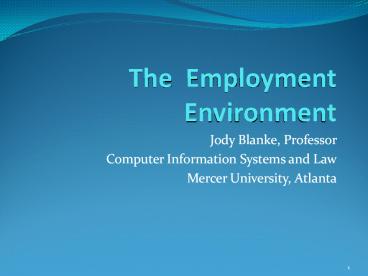The Employment Environment - PowerPoint PPT Presentation
Title:
The Employment Environment
Description:
Jody Blanke, Professor Computer Information Systems and Law Mercer University, Atlanta * Recruitment Common Law Misrepresentation and Fraud Application of Regulation ... – PowerPoint PPT presentation
Number of Views:28
Avg rating:3.0/5.0
Title: The Employment Environment
1
The Employment Environment
- Jody Blanke, Professor
- Computer Information Systems and Law
- Mercer University, Atlanta
2
Recruitment
- Common Law Misrepresentation and Fraud
- Application of Regulation to Recruitment
Practices - Advertisements
- e.g., recent college grads
- Word-of-mouth recruiting
- EEOC v. Chicago Miniature Lamp Works, p. 113
- EEOC v. Consolidated Service System, p. 116
- Nepotism
- Promoting from within
- Neutral solicitation
3
Information Gathering and Selection
- The Application Process
- The Interview
- forbidden questions
- Background or Reference Check
- Resume fraud
- e. g. ,George OLeary
- Social media
- e. g. ,Facebook, LinkedIn
- Potential liability for providing references
4
Information Gathering and Selection
- Negligent Hiring
- After-Acquired Evidence Defense in Wrongful
Termination Suits
5
Testing
- Legality of Eligibility Testing
- e.g., intelligence tests, physical tests, eye
exams - Title VII exempts professionally developed,
validated employment tests of eligibility from
disparate impact claims - in order to be legally validated, an employer
must show that the test is job-related and
consistent with business necessity - e.g., math test for a cashier
- e.g., English competency exam for customer
support position
6
Test Validity
- Criterion-Related Validation
- the test must be shown to accurately predict job
performance as evidenced by the ability to do the
job - e.g., a simulated exercise to predict job
performance - Content Validation
- the test specifically measures performance of
certain position requirements - Construct Validation
- examines the psychological make-up of the
applicant and compares it to those traits
necessary for job performance
7
Test Validity
- Job-Related Requirement
- In addition to validation, an employer must show
that the specific trait being tested is
job-related - e.g., Evans v. City of Evanston, physical agility
tests for firefighter positions had a disparate
impact on females, but were rationally related to
a legitimate purpose - e.g., Griggs v. Duke Power Co., intelligence
tests were not shown to be related to job
performance
8
Test Validity
- Integrity and Personality Tests
- must be related to job performance
- e.g., Soroka v. Dayton Hudson Corp., p. 143
- Physical Ability Tests
- usually a simulated task related to job
performance - e.g., tests for firefighters involve dragging
objects or climbing stairs - Medical Exams
- are permitted post-offer, pre-employment for the
purpose of ascertaining whether the employee can
perform the job
9
Testing
- Legality of Ineligibility Testing
- e.g., drug tests, polygraphs
- Federal Employee Polygraph Protection Act of 1988
- because of inaccuracy, polygraphs are generally
prohibited - exceptions for security service companies,
controlled substances, and government employees - and for Investigation Exception, p. 148
- Many states also prohibit polygraphs
10
Testing
- Drug-Free Workplace Act of 1988
- Applies to federal employees
- National Treasury Employees Union v. Rabb, p. 154
- Private Employers Have Also Implemented Drug
Tests - mandatory testing
- probable cause testing
- random testing
- The Genetic Information Nondiscrimination Act of
2008
11
Performance Appraisals and Evaluations
- Disparate Impact
- an appraisal system with a disparate impact would
be subject to high scrutiny by the courts - might by determined by four-fifths rule
- Disparate Treatment
- an appraisal system might use different criteria
for a protected class - e.g., Hopkins v. Price Waterhouse
- Defamation
- Jensen v. Hewlett-Packard, p. 168






























